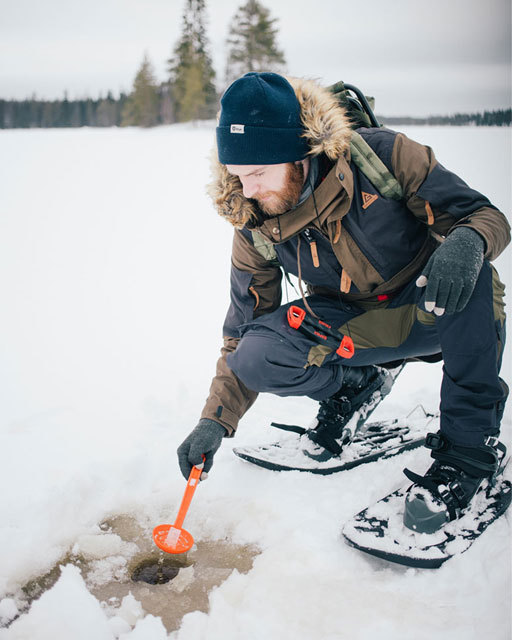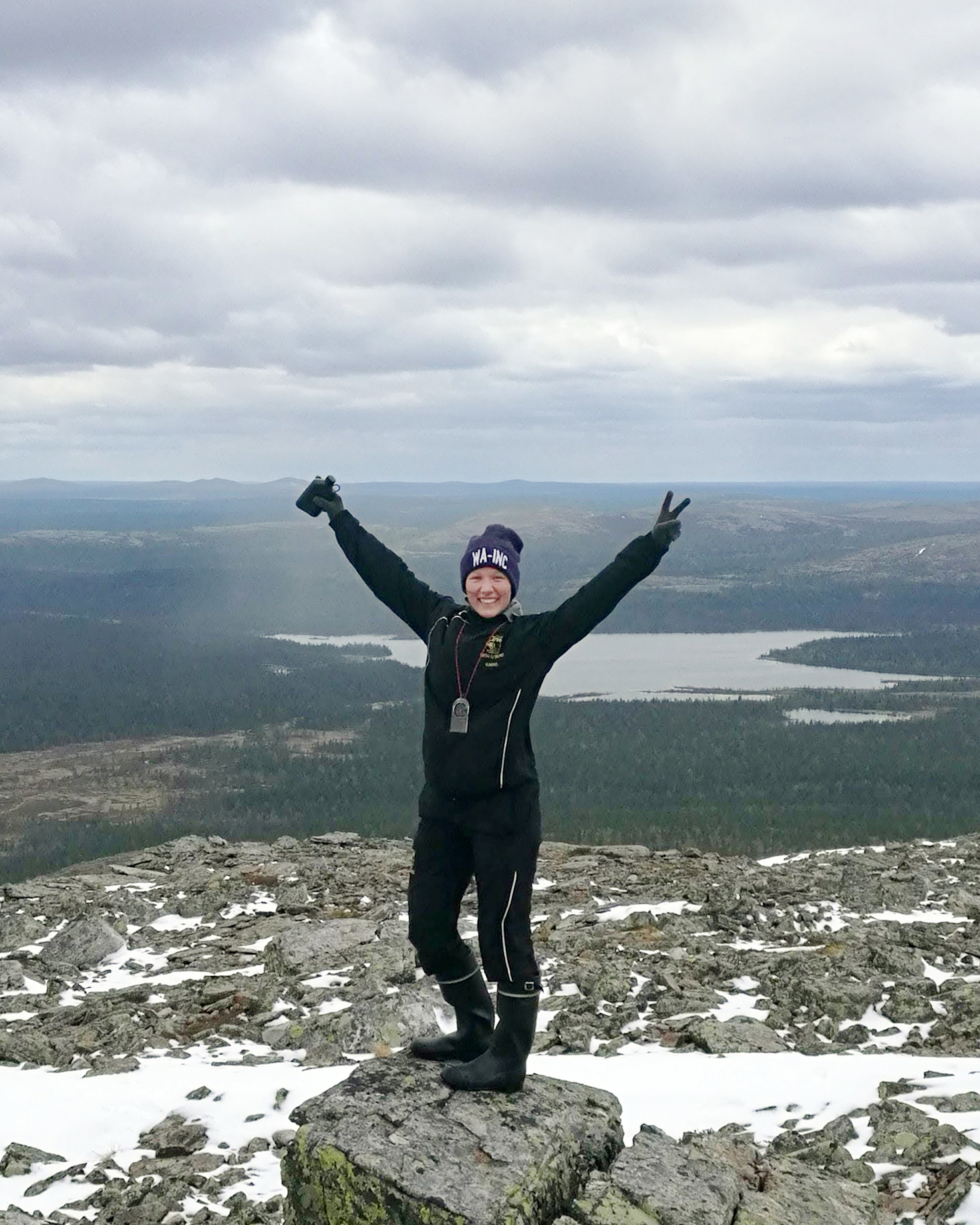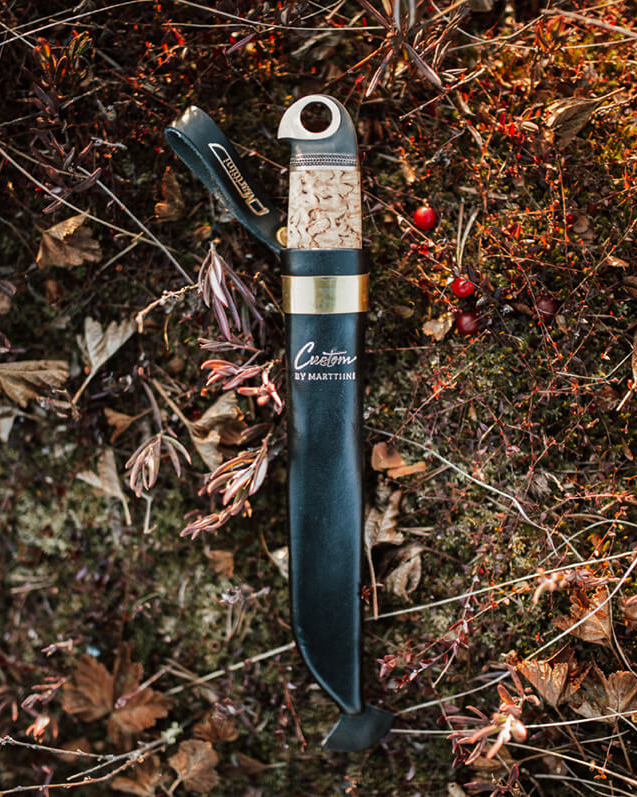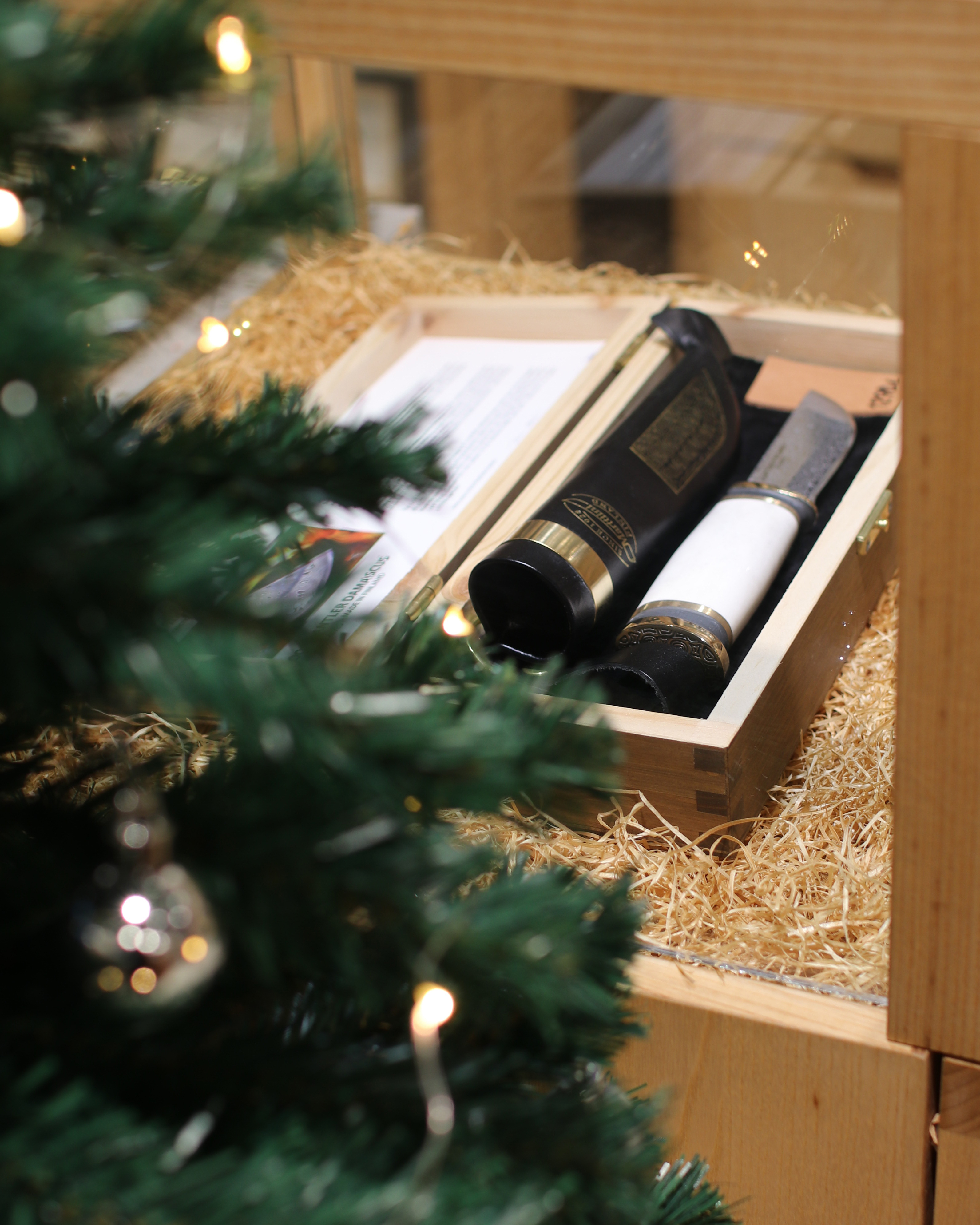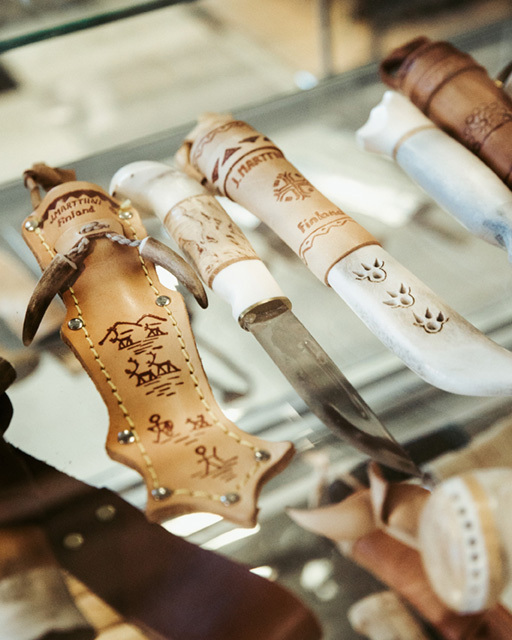MARTTIINI SHOP Story of Marttiini Stories
Stories
The Knifemaker's Cut
We’ve been making knives since 1928 – almost a hundred years. During those years, we’ve had the privilege of hearing countless wonderful stories about knives, people, and the outdoors. We thought now would be the perfect moment to share these stories. We hope you enjoy reading these stories as much as we enjoyed hearing them. Stay tuned for more stories to inspire your inner wilderness.
A Lesson in Reconnecting
Reading time: 7 min. What happens when you take a person and put them in the middle of the Karelian wilderness? In the late winter of 2022, Padraig Croke participated in Karu Survival’s wilderness course, where he glimpsed into the wild – and got a bit closer to the mystery that is Finnish nature. Here, Padraig unpacks what he learned about the origins of the Finn’s remarkably close ties to nature – while, of course, including his notions of a certain Marttiini knife.
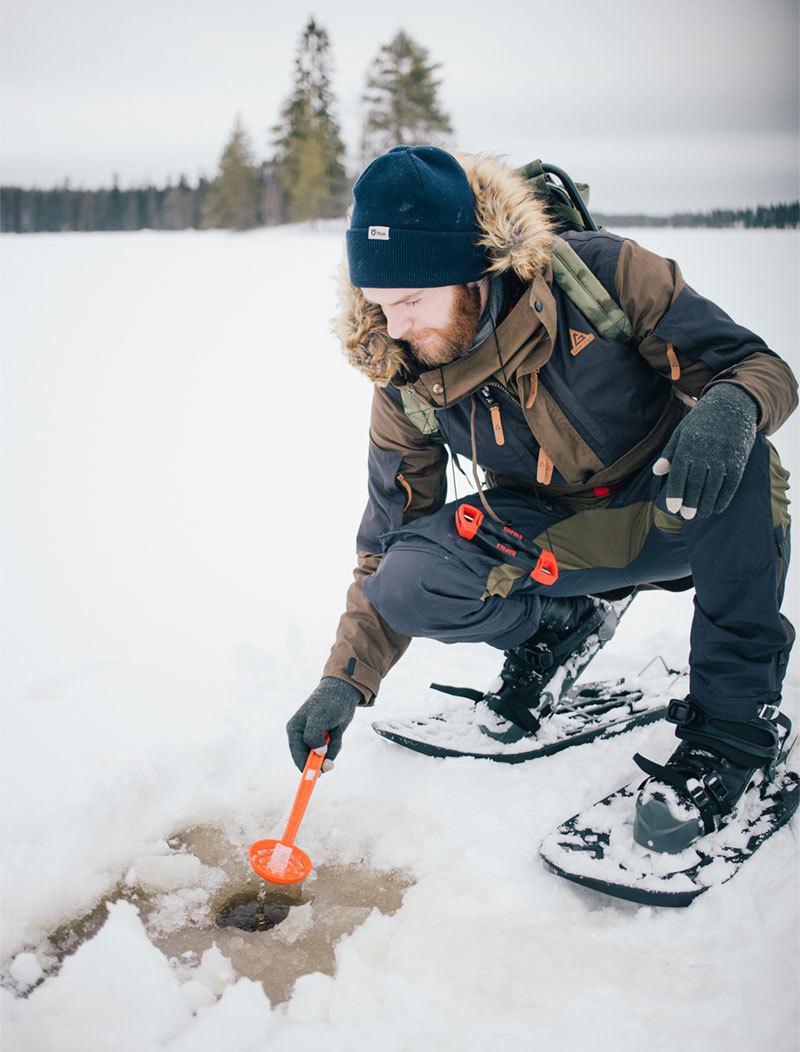
Yours truly inspecting the window in the ice. Ice fishing is an art of patience – but often, that patience is rewarded.
“The modern world has dulled our senses quite a bit. We don’t see in the dark like our ancestors did. Nor do we hear as well as they did because the information coming at us today is constant!”. I have just spent the last week with Mikko Kettunen at his outdoor school, Karu Survival, learning some of the skills that have kept people alive up here through the long cold months of winter for centuries.
Forest skiing, woodland navigation, plant and animal identification, fire lighting skills, and cooking skills. Not rocket science… just the basic common skills of the Finnish homestead.
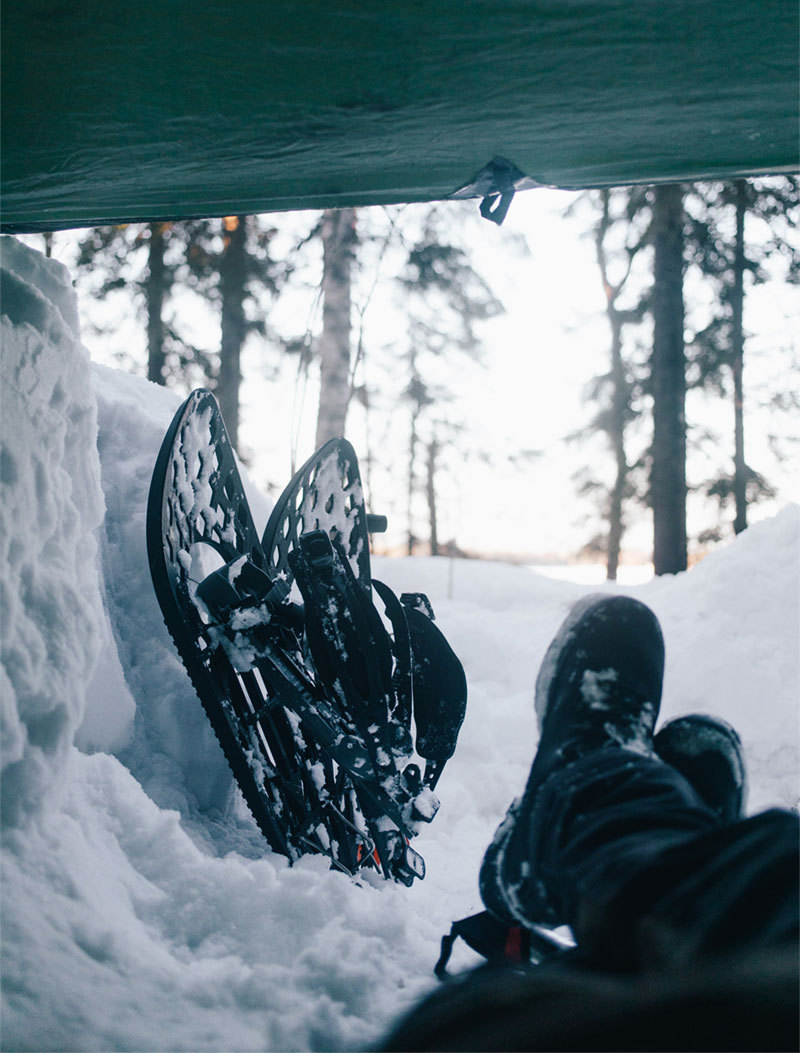 With the right equipment, the wintery wilderness welcomes its visitors.
With the right equipment, the wintery wilderness welcomes its visitors.
We are sitting in the kota, a small circular hut with benches along the walls, a firepit in the centre, and two small windows on each side. It sits on the shoreside of the frozen lake that I’ve become familiar with over the last number of days, and on this crispy night, the stars are in their thousands above us. Bright hot flames crackle in the pit as the resinous pinewood spits protesting sparks in our direction. With just this firelight to see, we talk about reconnection.
“What I like to do is block my senses. I will go to the forest, block my eyesight and my hearing as best as I can. Then I use my senses from my feet and my hands and I start touching things. I feel with my feet on the ground and think…okay… pine needles. I will put my hands on the leaves and recognise blueberries, or lingonberries. This leaf is waxy… For me, this is about reactivating my senses. And it is fun also!” Mikko says.
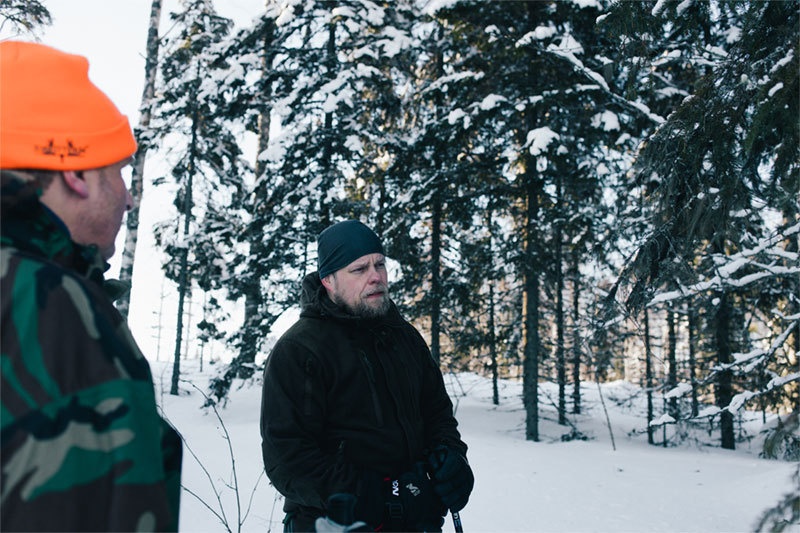 Mikko Kettunen teaches us to read the blank page of the forest. The marks reveal themselves to those who pay attention.
Mikko Kettunen teaches us to read the blank page of the forest. The marks reveal themselves to those who pay attention.
They call Finland the land of a thousand lakes. 10 % of this country is covered by water… making it over 180,000 lakes, in fact! Not to mention the miles upon miles of forests and woodlands. There is something in the air here that seems to draw people into nature without making too much of a fuss about it.
What I, or perhaps someone from my part of the world, calls bushcraft, a relatively new term to me, the Finns would simply call camping!
They seem to have it in their bones, and most people I have spoken to have spent at least one summer of their childhood in wild places, with just a wood-fueled sauna or a lake to bathe in for the whole season. Summers spent with their grandparents or extended family that seemed to last forever. But it is getting rarer, it seems.
We talk about this while sitting in the kota: “People are isolating themselves from nature today. It’s like some scary mysterious place that we need to protect, but it’s also kept away from us. We’re admiring it from a distance and don’t consider ourselves part of it… which we are”.
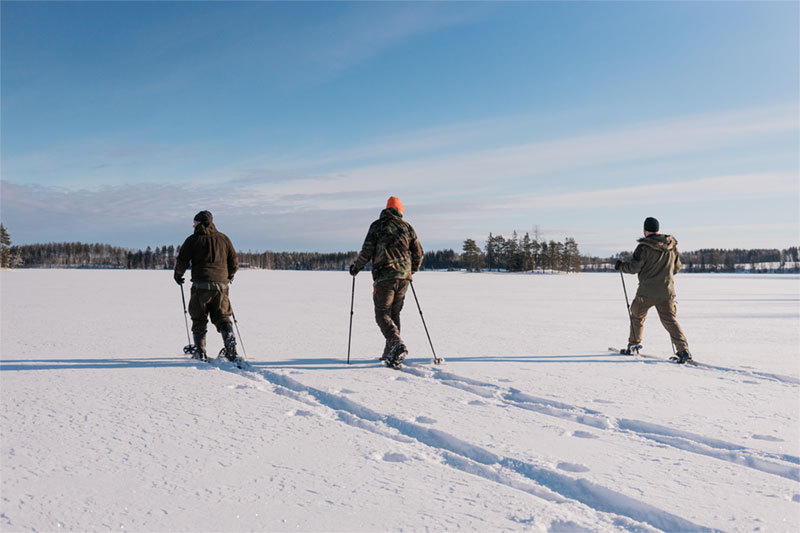 Active days call for moments of absolute idleness!
Active days call for moments of absolute idleness!
One of the best pieces of advice I’ve ever been given, when it comes to undertaking adventures, is ‘learn from the locals’. Whether it’s the best spots on the river to fish, the safest path up a mountain, or even the best restaurants to eat at in town, local knowledge is priceless! Mikko's understanding of the natural environment and his outdoors skills come from both his own career in the Finnish Military, and from his life as a student of his surroundings; the wilderness of Karelia where we now are.
By the third day of our adventure, we have all become well acquainted, and the ‘local knowledge’ is filling my head as quickly as I can get it down on paper. A fluid combination of classroom-type lectures on fishing and fire skills, as well as practical classes involving pulkkas and traveling across the land.
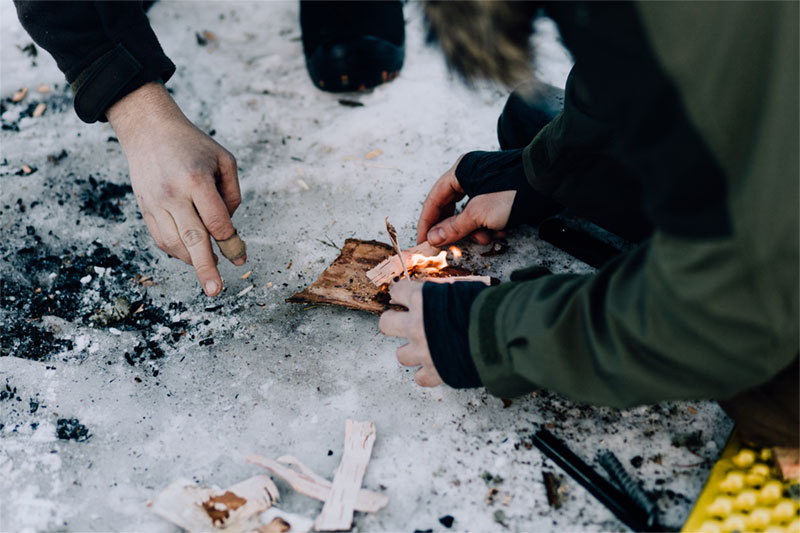 With a source of heat, the wilderness becomes hospitable.
With a source of heat, the wilderness becomes hospitable.
There is a sense of teamwork and camaraderie building between myself and the two guys taking part in this course with me. There's an English guy about my age and a 192 cm tall Dutchman we have affectionately nicknamed Cruise Control – because he always gets the job done, it’s just done according to his own schedule. I think he likes his new nickname.
We have been digging shelters with shovels and my wrists are throbbing from the impact against the icy snow. It reminds me of when I used to box a heavy bag and I think to myself that hand wraps would be useful. We are working for our food here, and my body and mind are energised by it. I get my first taste of forest skiing, which I’m not very good at, but I still enjoy it immensely.
Using these skis, we navigate the woodlands around the cabin as Mikko points out to us the most subtle of signs that I would not have noticed before. Here, the footprints of a mouse, there, a sign of squirrels feeding. When you start to train your senses, the snow becomes like the white page of a book, the animals using it to write their stories.
Some day I hope to be as literate in the forest as this, but I know this will take many more years. This is the connection I have come here to learn.
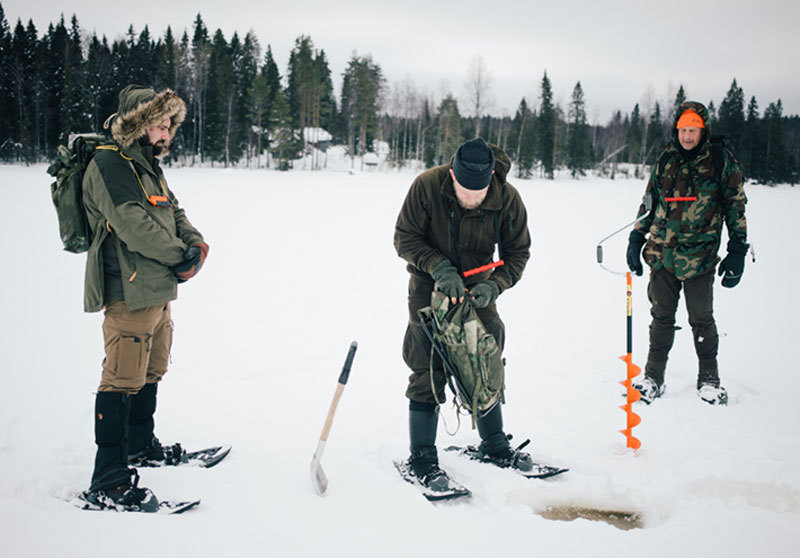 Who’s up for ice swimming? No one?
Who’s up for ice swimming? No one?
If there was one object I would use as a symbol of this national connection to nature, it would, without a doubt, be the puukko knife. A practical, simple tool that allows the user to make use of the resources that nature offers. To be part of its system and to respect what it can provide. The puukko's handle and sheath are often made from these natural resources; birchwood, animal bone, leather, and antler.
In Finland, receiving a puukko as a gift is considered an honour, the idea being that the presenter is giving the recipient a tool essential for both woodworking and preparing food, and that the presenter holds the well-being of the recipient in high value. Almost everyone here remembers their first knife, and usually, it's their father’s (or grandfather's) old Marttiini fishing knife.
Mikko tells me about his first knife:
“When I was about five years old, I told my dad that I wanted to have my own knife, because every boy had to have their own knife. My dad replied “Ok, come here” and he went and got his old fishing knife. Ugly as hell! But sharp as hell also. He handed it over and my knife training lasted about ten minutes. He said “never use the knife between your legs. Always keep it in the sheath when you’re not using it. Never run with it. And when you cut yourself come to me and I’ll put a plaster on it”. And then he left me at the side of the house with a pile of firewood, and so I took a piece of wood and started carving.”
If you want the best, use what the locals use, it seems!
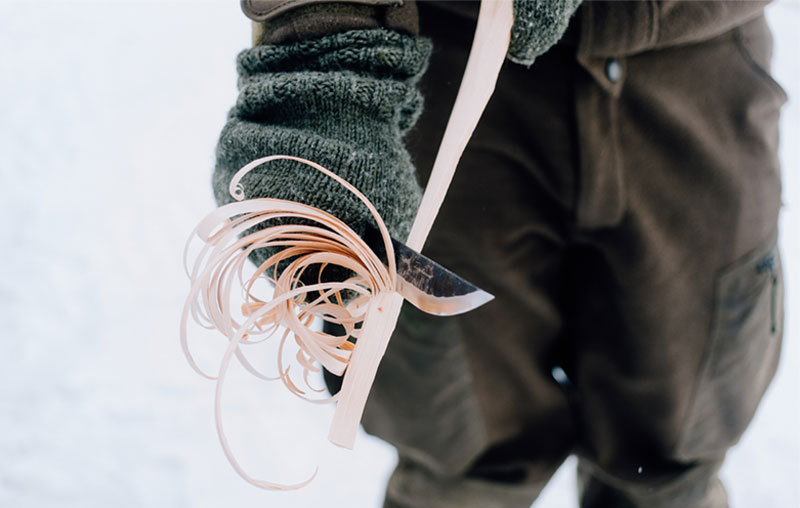 Mikko puts Aapa to the test. In expert hands, the wood is quickly transformed into feather sticks.
Mikko puts Aapa to the test. In expert hands, the wood is quickly transformed into feather sticks.
So, when coming on this course, I opted to bring my Marttiini Aapa knife with me to see how it fares in the country it was built in. I hand it to Mikko during our firemaking lessons to see what he thinks. Standing in place, he quickly gets a feel for it before expertly placing it onto the sliver of wood he's currently holding and begins to make fine feathers along one of the edges. “Oh, this is very nice…”. The knife acts like it’s been in his hand forever and we discuss some of the features he looks for in a knife. “I like how deep it sits in the sheath, this will not fall out in the woods!”.
I mention that I also like the swell on the butt end of the handle, especially when I’m wearing gloves, and he agrees with me. And so, with a thumbs up from a local, I happily return my puukko to its sheath, where it lies ready to take on whatever that's in store for me during my stay at the survival camp.
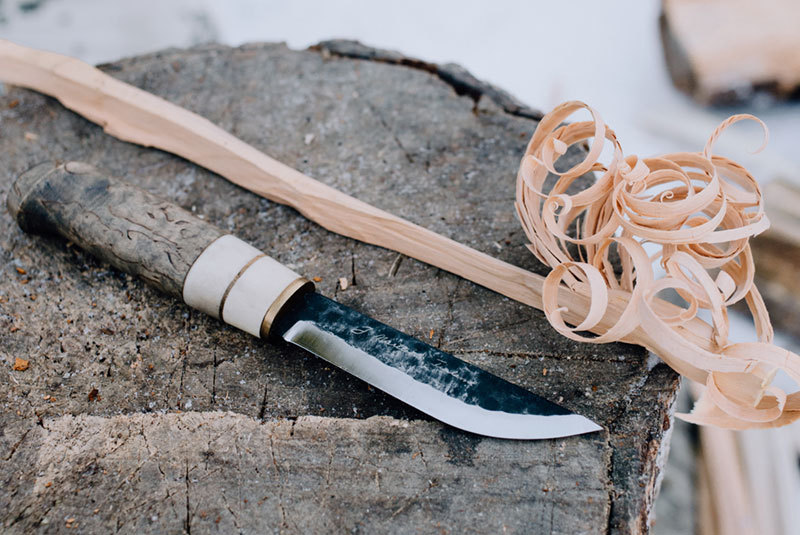 Test passed – with flying colors!
Test passed – with flying colors!
By the time I left for home, back up to Vaasa on the west coast, I felt both exhausted and invigorated, my mind full of new ideas and concepts. This country I now live in, its philosophy and it’s no-nonsense attitude towards the natural world are, I think, starting to make a little more sense to me.
But I would not pretend to have all the answers, and I know it will take me years to dig through just the topsoil of the complexities of the culture here. They say the Finnish language is one of the most difficult in the world to learn, not only for its technical complexity, but for its ability to describe things in such subtle and nuanced ways. They have, for example, forty (yes, forty different words!) to describe snow.
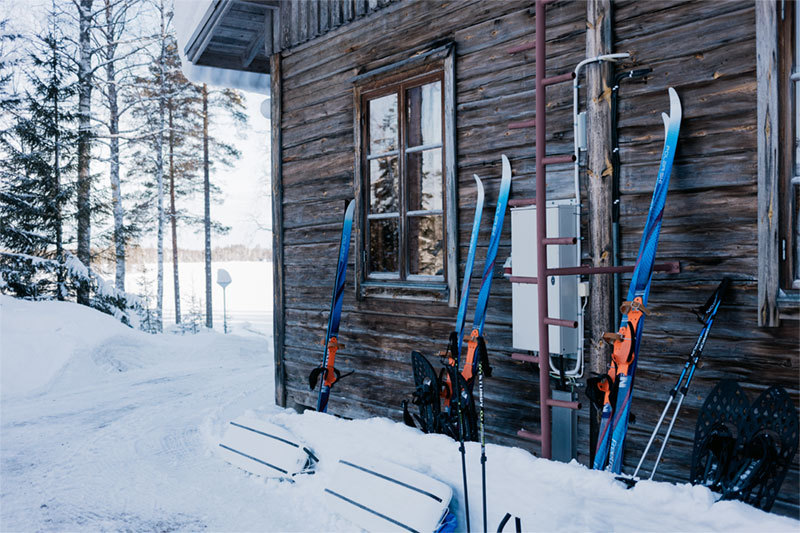 Forest skiing – tough but immensely enjoyable!
Forest skiing – tough but immensely enjoyable!
The Finnish people, just like their landscape, are comfortable under calm silences, but under that, there is a pride in being close to the soil and being a part of the natural world. It seems I still have a lot to learn. But who better to teach me, than the locals?
Text & Pictures:
Padraig Croke
www.padraig.me
One with the landscape – the Scout’s Knife and I
Reading time: 3 min. There aren’t many things as pleasant for a knife manufacturer as hearing stories of knives that have been traveling with someone for decades. We at Marttiini also get to hear such stories almost weekly. To us, that is a sign of work well done. For the owners of the knives, it is even more: it is a symbol of shared moments and a sign of continuity. Of how some things will stay the same for years and years.
One such knife is a Scout’s Knife that has been travelling in the wilderness and on fells for over two decades with Minna. Minna Kakko has hiked since she was a child and got the knife as a gift from her father, who thought that a proper hiker needs proper tools.
“I have always been an outdoor person – and no wonder, because my father took me on hikes starting from when I was 8 years old. Often, the trips would be several days of hiking on and near fells and sleeping in a tent or in wilderness cabins. When I was 10, my father said he felt we were experienced enough as hikers to get proper knives. So we got Marttiini knives,” laughs Minna.
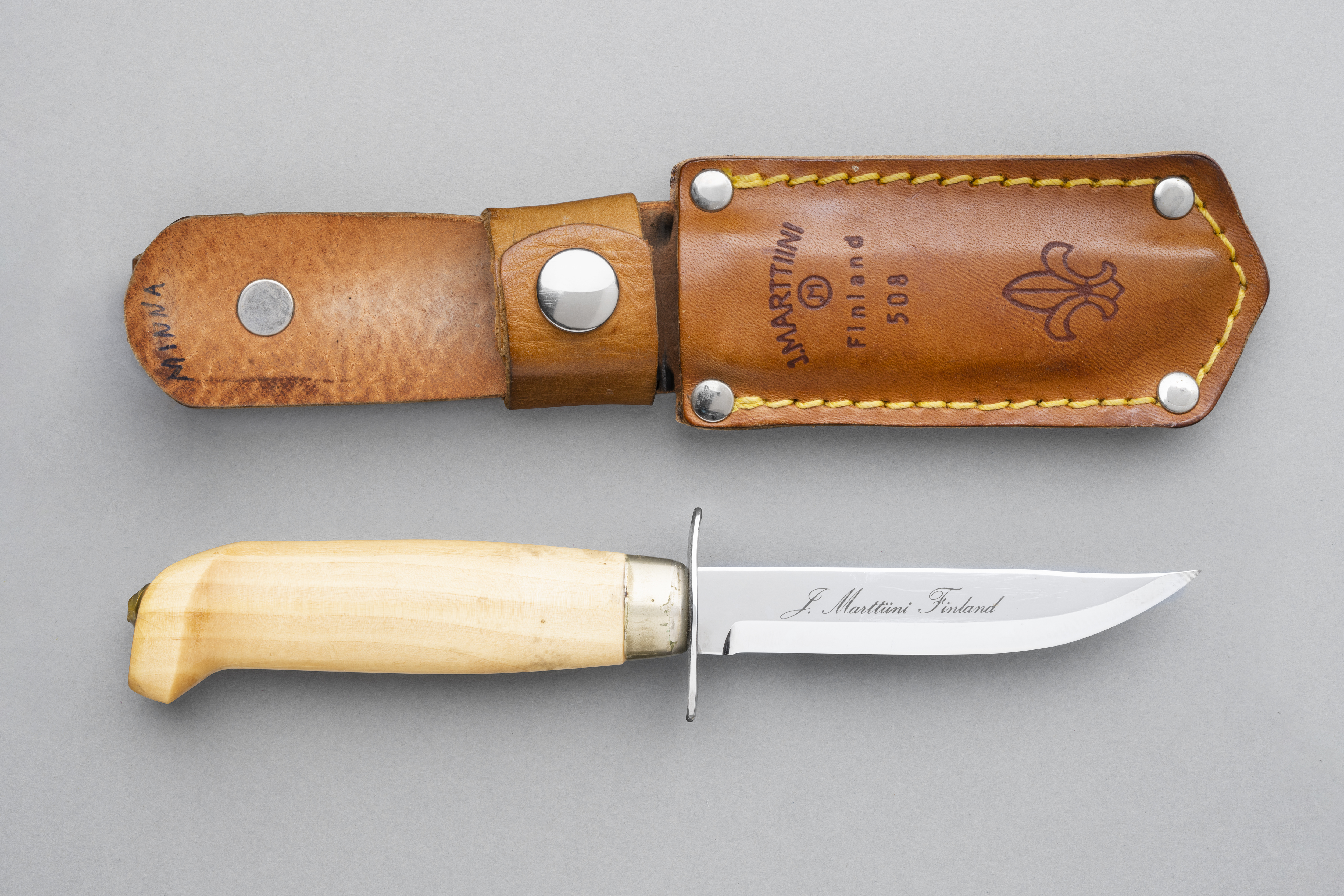
From a student to an experienced knife user
That is how the Scout’s Knife found its way into Minna’s life. These days, the knife is like an old friend, with habits and characteristics you know like the back of your hand. However, at first, the young hiker had lessons to learn because nobody is born ready.
“I can clearly remember the first hike I did with the Scout’s Knife. In fact, I have souvenir from it. We were making bark boats together with my sister when, because of my lack of experience, the knife slipped and cut my finger. Crying, I showed the cut to my father who told me not to cry because it would leave a nice scar as a souvenir! And that got me crying even more,” Minna says, laughing. “Although I was sad then, remembering that story now puts a smile on my face.”
(On behalf of Marttiini, we would like to note that we recommend that the youngest hikers use our Junior series knives, which are designed for small hands and have a duller tip, the Condor Junior and Deluxe Junior. With them, things like learning to whittle are easy and safe to do.)
Although the first encounter with the knife did not go quite as planned, since then it has become a trusted tool and companion to Minna.
“I don’t think there is a single hike where I did not need the knife! The knife is a versatile tool: you can use it to whittle feather sticks, make a spark, open bags of food and cut rope. In the wilderness, you never know when you will need a knife – that’s why you should always carry one.”
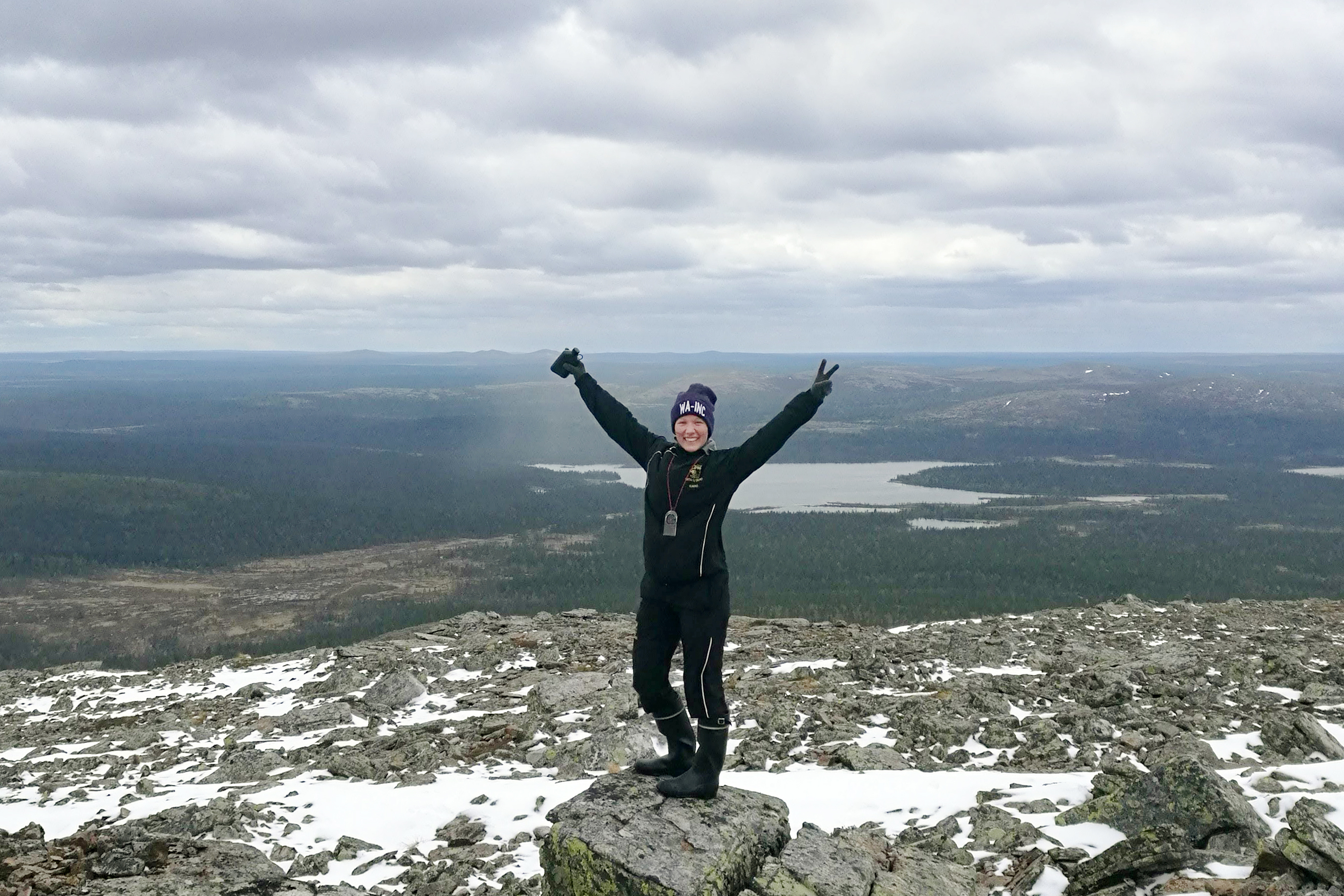
On top of Sokosti (718m), the highest fell in Urho Kekkonen National Park.
Becoming a part of the landscape
The hiking hobby she started as a child keeps on giving. Even though in her teenage years other interests captured her attention for a moment, as an adult Minna returned to her roots as a hiker. She found a hiking partner in her spouse and hikes of several days have become a fixture of their year.
“There is something in the fells that calls to me. It feels like I belong there, like I am one with the landscape. There, I can also be in peace with my own thoughts, which these days is very refreshing. I also notice that I go back to the same areas where I hiked as child! Maybe I really am one with that landscape,” Minna says.
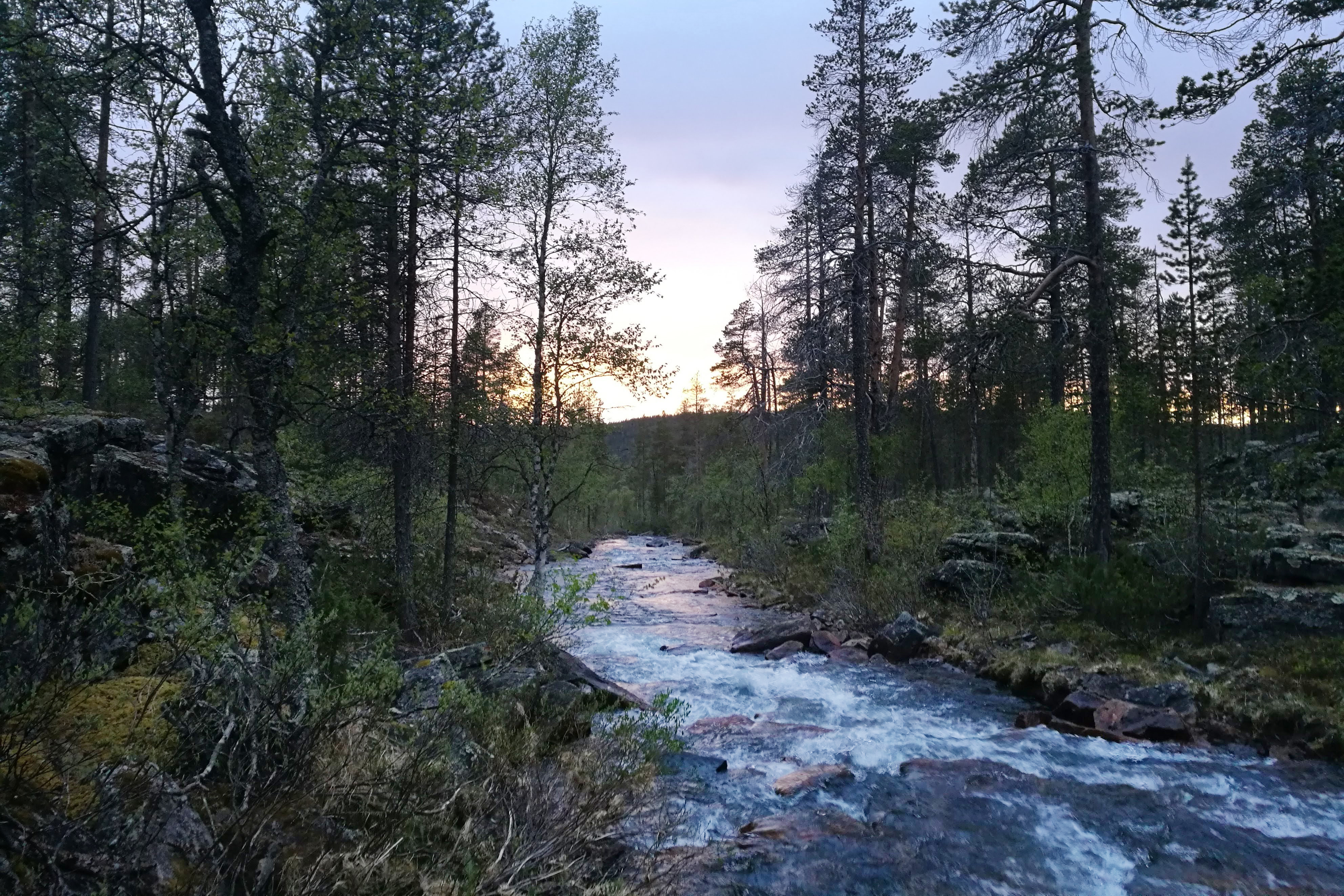 Landscape in Saariselkä, Lapland
Landscape in Saariselkä, Lapland
In addition to her spouse, there is something else Minna always takes on her hikes – her Scout’s Knife.
“I have had the knife on every hike ever since my father gave it to me. And why not? It’s a really good knife to use! And if I remember correctly, I’ve never had to sharpen it once – unless my father has serviced it in secret,” laughs Minna.
“The Scout’s Knife has also become a very dear item to me over the years, as it was given to me by my own father. There are many fond memories related to it from various hikes.”
That is exactly the way it is: in the best case a knife is much more than just a practical tool. It can hide many real-life memories and meanings that are a joy to carry with you. Please get in touch if you own a knife that you have had for long and the story of which you would like to share! As said: there aren’t many things as pleasant for a knife manufacturer as hearing stories of knives that have been travelling with someone for decades.
- The Scout's knife is available online, at Marttiini stores and retailer's.
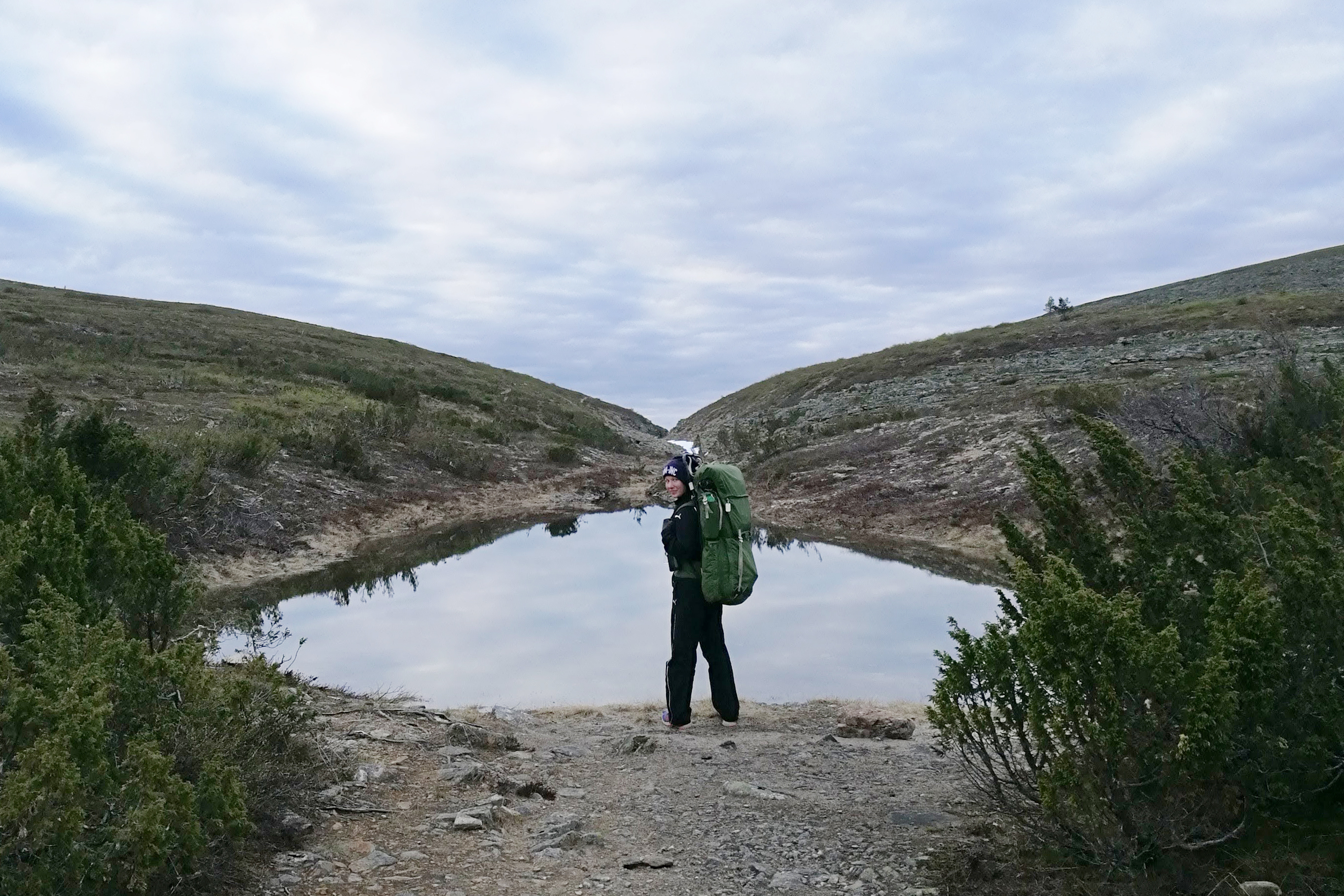 Kuutamokuru, Saariselkä, Lapland
Kuutamokuru, Saariselkä, Lapland
The story behind a Custom knife: Krista Ylinen's Nomad
Reading time: 4 min. A knife is versatile. It can be a trusty companion on hikes, a prized inheritance or the crown jewel of a display cabinet. A knife can also reflect your own identity – especially if you designed the knife yourself. In the series ‘The Story Behind a Custom Knife’, owners of Marttiini Custom knives share the unique stories of how their knife was born and tell about what their knife means to them.
When photographer Krista Ylinen started to design her own Marttiini Custom knife, a few things were clear from the very start. Number one: this knife would travel with her in the outdoors. Meaning it would have to be practical. Number two: a knife can include significant symbolism. That means tailor-made details would have to be carefully considered.
Guided by these criteria, she started the design process of trial and error involving the combination of different materials and properties in Marttiini’s Custom Shop – and then finally finishing. The Nomad was created, a knife just for Krista Ylinen. A custom knife that meets the needs and wishes of its maker. And the knife really does look like its designer.
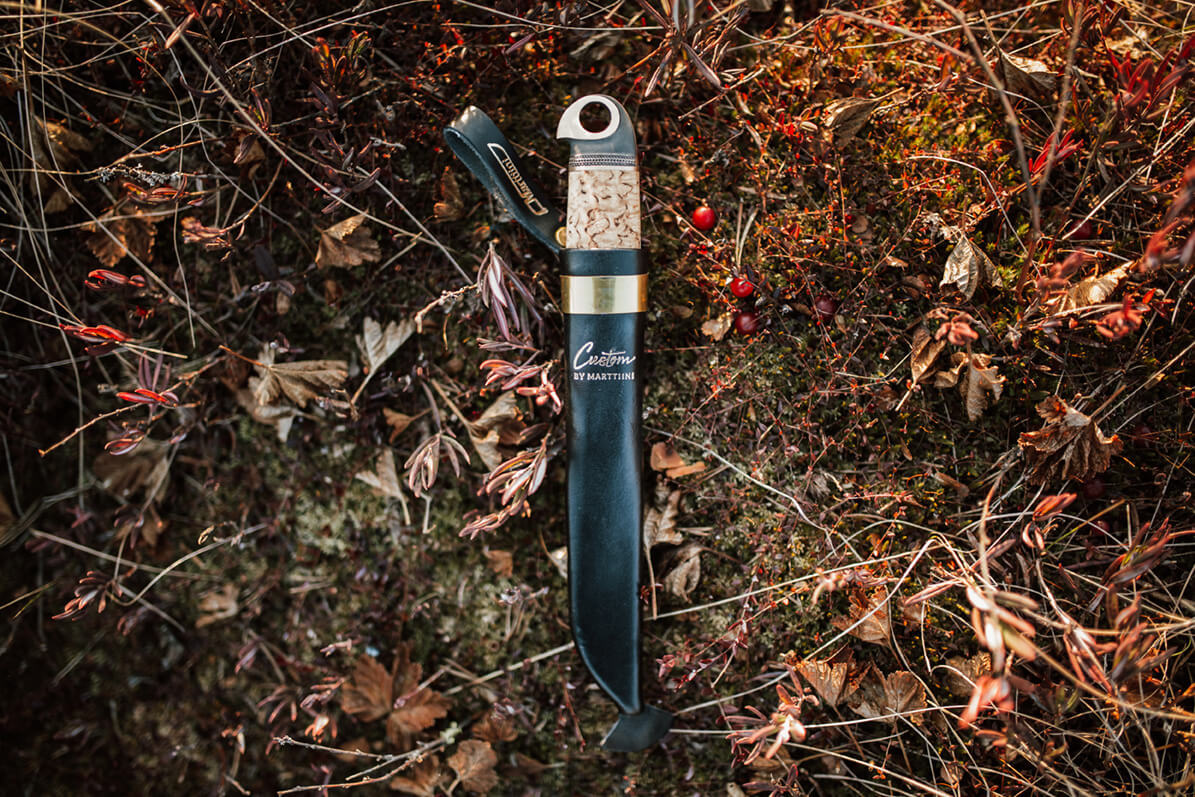
A knife for marshes and fells
Let’s start with the practicality. The knife of a person moving around outdoors must be functional. Everyone who has ever carried a knife in the wilderness knows this. Practicality is also evident in Krista’s custom knife.
“I wanted an all-round knife that meets my needs – making fire, whittling and cutting food. And this can of course be seen in the result. I chose hard-wearing carbon steel as the blade material and beautiful curly birch for the handle. I also wanted a finger indentation in the handle to improve grip and prevent my hand from slipping onto the blade,” Krista explains.
A practical knife is also practical when it is not being used – often that is the measure for real practicality. Often, outdoor trips will include quite a lot of walking, climbing and even scrambling. Every gram is precisely weighed, especially when heading into challenging environments. Krista also considered this aspect when designing Nomad.
“I especially enjoy hiking in marshes and on fells – and I wanted to take Nomad along on both longer hikes as well as daytrips. That is why it was important that the knife was the right size and light enough. The number of materials to choose from was actually higher than I had imagined, but with time I found a combination that pleased me. Experimenting with different materials was a significant part of the process!”
Krista has a notable history as a photographer and many Marttiini enthusiasts are sure to already know her work, because she has in fact taken many of the stunning Marttiini photos! For this master of her craft, who has already been photographing knives for a long time, it was important to make sure that the visual element of her knife was also in order – a well-designed utility knife is also a display knife. And the knife did turn out beautiful. The contrast between the blonde curly birch and the dark carbon steel will instantly capture the viewer of the aesthetic Nomad, crowned by the bronze eagle on the bolster.
In the tracks of nomads
There is also symbolism behind the details – just the kind of significance that a knife may carry. Stories that give a knife its character. Viewed from this perspective, even the eagle on the bolster gains entirely new significance.
“The eagle bolster was of course beautiful in its own right, but there is more to it. Long ago, I had a project where I was photographing eagles. Doing that, I developed a special bond with them,” says Krista.
There is also meaning to the name of the knife. As one can expect, the Nomad is named after nomadic people who do not settle down, but live their lives roaming around. Engraved on the blade, the name of the knife is a reminder of that lifestyle.
“The nomadic lifestyle has always fascinated me. I feel like I am similar in nature – always packing, always going somewhere,” Krista exclaims.
A journey into the self and the current moment
And we are indeed on a journey, often further from the hustle and bustle of cities and closer to nature. Krista also finds nature to be significant resource.
“In nature, things become simpler, clearer and cleaner. My relationship with nature is an important resource that enables me to get more closely in touch with myself and the current moment. Often, the best memories are of overnight trips. They allow you to get further into the terrain and be more adventurous.”
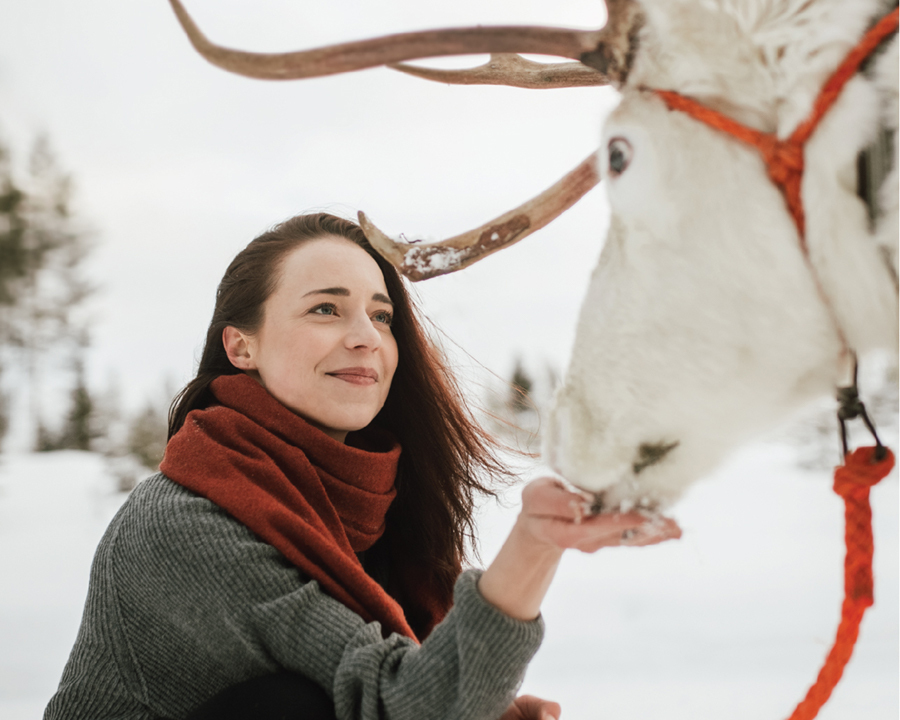
Adventure, relaxation and living in the moment – that is outdoor life at its best. And many more things, because a good outdoor trip will always look like the person on the trip. At best, a knife can also become a part of that great experience. As Krista puts it, a knife you design yourself can be more than just a tool and a piece of safety equipment. It can also be a reflection of your identity.
“Nomad carries a lot of emotional value for me. No wonder that a custom knife will easily become very personal and dear, because it allows you to combine just the elements that you feel are significant. And it’s lovely to then carry them around with you outdoors.”
Marttiini's Tips for the Perfect Gift
Reading time: 3 min. A Marttiini knife is a gift you can hand out with pride. We want to help you find the perfect knife. With all the options available, it’s easy to get overwhelmed. That’s why we’ve decided to compile a list of Marttiini favorites.
What to get for Dad, who’s recently got knee-deep into cooking? Or for Mom, whose greatest passion in the world is warming up the sauna? Or for the design-loving partner or the friends who consider themselves hard-core anglers? With so many questions in the air, we’ve compiled a list of six sharp ideas to help you.
Gifts come in many shapes and forms – and who says you even have to get presents? However, if you wish to delight your loved ones with long-lasting gifts, this list can be helpful.
Aapa – Beauty and Power Combined
If you want to surprise someone with a versatile knife that pays homage to traditional design, you can’t go wrong with Aapa. With its blade made of forged carbon steel, Aapa has quickly become one of our most popular models. And that’s no wonder! The stylish, burly, and yet so handy Aapa is an excellent candidate for the knife-of-choice for hiking trips, making it a wonderful gift for any friend of the outdoors. The soft carbon steel is easy to sharpen, making Aapa a gift that keeps on giving for years to come.
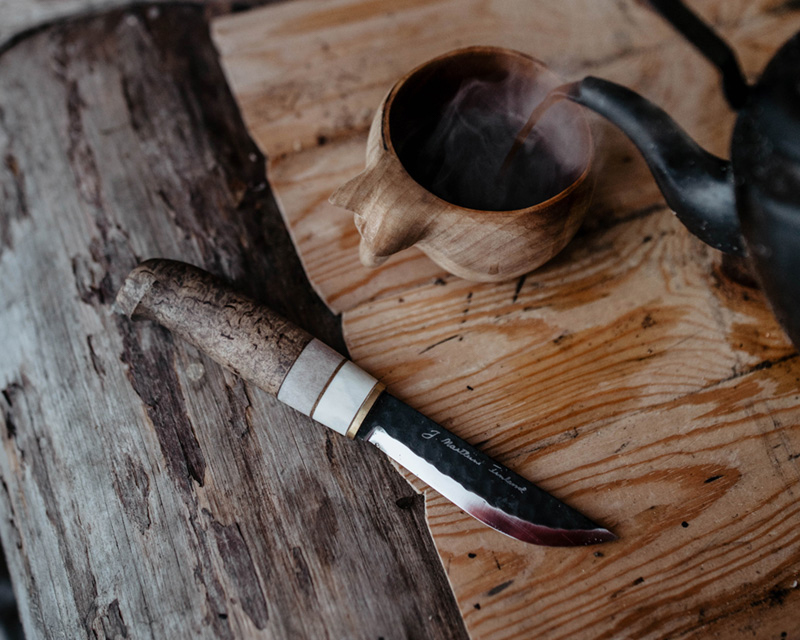
Carbon Lapp Knife 240 – A Combination of Carbon Steel and Classic Design
For years, friends of Marttiini had wished for a Lapp knife with a carbon steel blade. Of course, we couldn’t let that wish go unheard. Rapidly rising to the ranks of other all-time favorites from Marttiini, the Carbon Lapp Knife 240 is a sturdy knife – and an ideal gift for anyone looking for a tough knife for demanding tasks. If you’re looking for a present for someone who likes to carve feather sticks and prepare firewood with a knife, the Carbon Lapp Knife 240 is the way to go.
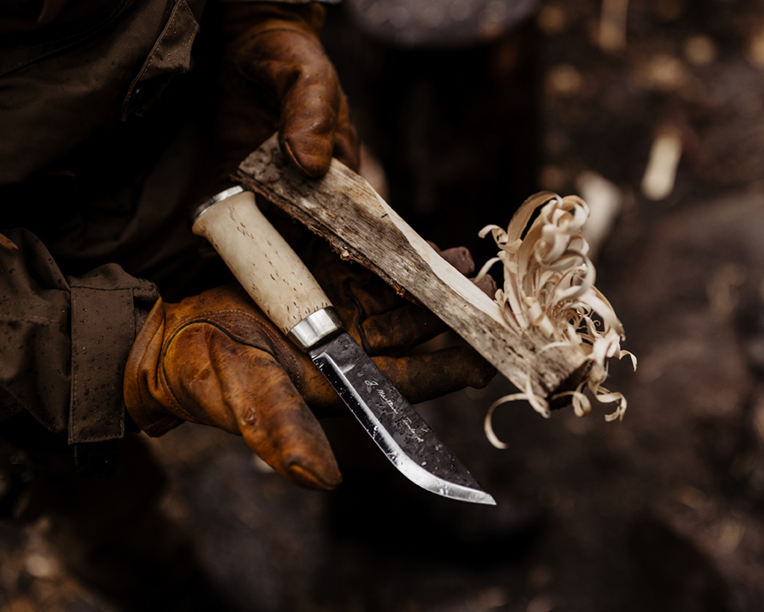
Deluxe Junior – The Little Hiker’s First Knife
A great gift for a nephew or a godchild, the Deluxe Junior knife is fit for any young hiker or scout. The knife’s finger guard and rounded tip make the Deluxe Junior a safe choice for the first knife – without demeaning its owner! As safe as it is, the Deluxe Junior is still a full-blooded knife whose stainless-steel blade cuts and whittles with ease.
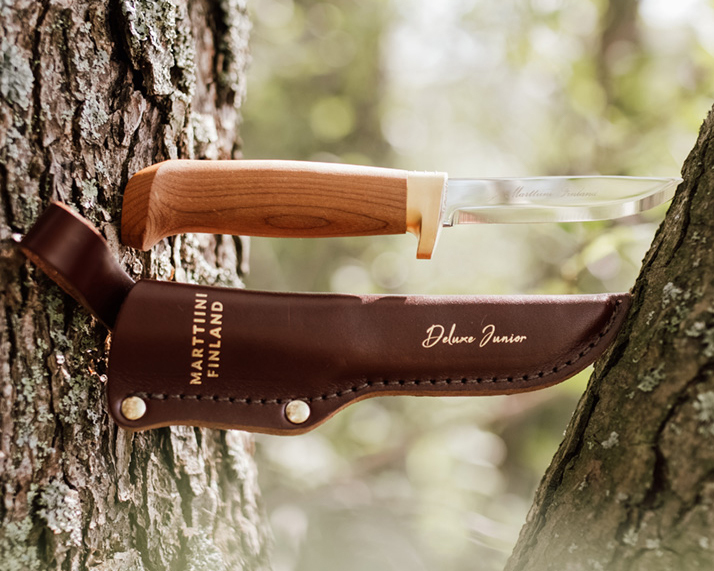
Martef Skinning Hook – Every Hunter’s Dream Gift
Got friends who hunt? Then this is going to be easy. With features to please any hunter, the Martef Skinning Hook is an absolute beast of a knife. The hook at the back of the knife helps to open the animal without touching the internal organs, while the round shape of the blade ensures that the hide comes off cleanly and intact. Nice and easy! The versatile blade is treated with a Martef coating that reduces friction and deters grime and corrosion. This gift won’t end up gathering dust!
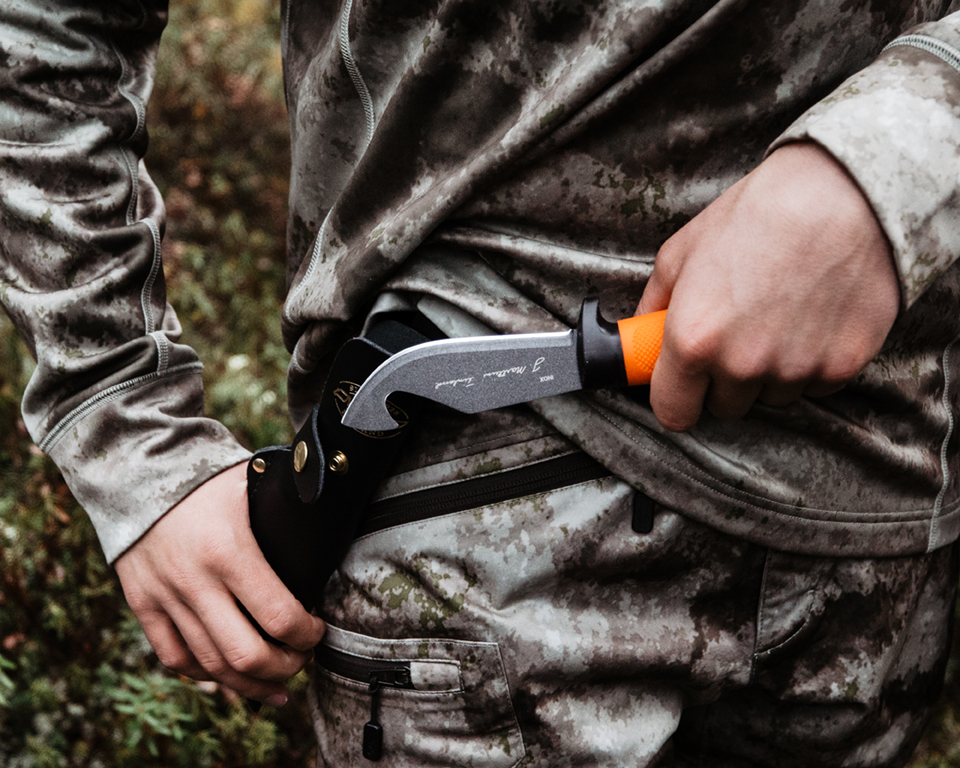
Condor Filleting Knife 19 – The Angler’s Must-Have Tool
Every angler – and every chef! – needs a proper filleting knife. If you are looking for a present for an avid angler or chef, you can’t go wrong with the Condor Filleting Knife 19. An unbeatable tool for preparing fish, the Condor Filleting Knife has a super-flexible 19-centimeter blade made from stainless steel. Like the other knives in the popular Condor series, the Condor Filleting Knife 19 features a textured rubber handle for firm grip and a finger guard for safe use. The Condor Filleting Knife 19 is at its best when preparing fish of about 2-3 kg, but it also works well when slicing vegetables, for instance!
Marttiini Custom – A Wonderfully Unique Gift
You can also surprise a loved one with a gift that’s truly unique – a Marttiini Custom designed together! With our easy-to-use online designer tool, you can combine different high-quality materials to bring together the knife of your dreams. And when it comes to giving gifts, it’s hard to beat the gift of sharing this process with someone close to you. You can give the knife a final touch by adding a blade marking to commemorate a special date, place, or name. It’s all up to you.
- Find more great gift ideas online, at Marttiini Brand Stores or resellers.
The story of Marttiini
Reading time: 4 minutes. In 1893, a child was born in Kierinki, who would introduce Finnish knives to the entire world. Marttiini has roots that go deep in the northern soil, and the story that spans over a century includes many twists: enormous amounts of money written on a napkin, conquering the world and knives with a bottle opener in the blade. This story is still alive today – you only have to look at Marttiini knives and hear the stories they tell.
The story starts in the North, in Kierinki to be more precise. Kierinki is a small village in the municipality of Sodankylä, far beyond the Arctic Circle. On 2 May 1893 a new child was born to the Marttiini family in Kierinki: Janne. Back then, nobody knew it, but Janne would go on to do many things and create quite a legacy while doing so.
From apprentice to master
The Marttiini household was a strict one and Janne embodied the entrepreneurial spirit from an early age. As often happens, a hard-working boy grew into a hard-working man, and by age 16 Janne was already making his first horseshoes as an apprentice to the blacksmith Matti Tapio, in Rovaniemi. After leaning the essentials, it was time to head back to Kierinki. Becoming the village blacksmith, Janne forged and sharpened, and soon the name Marttiini was recognized all the way to Vadsø, Norway. However, the most important year was still to come: 1928. The year, when Janne founded a factory.
A factory called Marttiini was established. The factory started making Janne’s vision a reality. A vision focused on knives that were beautiful but also hard-wearing ¬ seeing as how life in the north required grit and durability. The Marttiini knife factory, located on Vartiokatu in Rovaniemi, started producing knives that were nice to look at as well as use. The first was a 22-centimeter beauty with handle made out of curly birch and beautifully forged blade. The knife was indeed a sight to behold, but it did not have a name. Janne felt that the matter was important enough to involve the entire village in making the decision. A naming contest was organized to find the best name for the knife. The decisive proposal came from construction worker Kalle Palmu, who suggested the knife get a short and classic name with just the right feel: Lynx. And it was a good name indeed – along the years, Lynx has become one of the most beloved series by Marttiini. The first knife the factory ever made has also done quite well. The knife in question, the Lynx 131, is still available today. Among the most popular of the entire selection, a total of four million pieces have been sold thus far. Goes to show how far you can go with good planning.
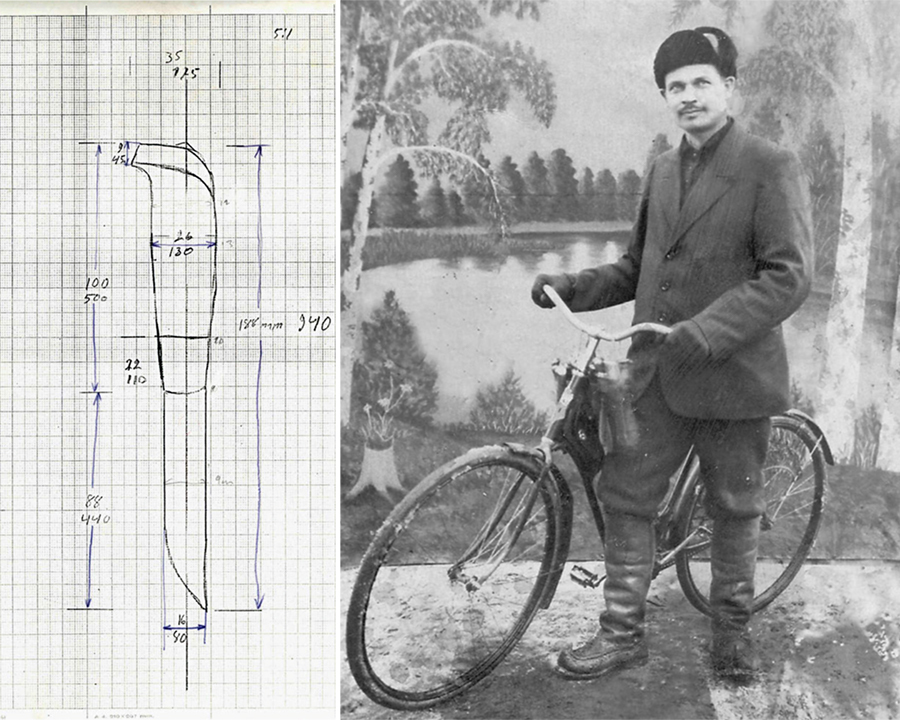
Marttiini conquers the world
Soon, the entire region was interested in the high quality of these beautiful knives. Janne had the gift of the gab and would make the rounds, selling knives – and the knives did sell. The Lynx 131 captured people with its sharpness and Janne won a prize for it in the Vyborg agricultural show. With ever growing fame, the Marttiini factory also kept growing, providing a living for Janne’s large family. There were some setbacks as well: the war scarred the North and the Marttiini factory was no exception. But determination prevailed. The destroyed part of the factory was rebuilt and a new wing added. As the years passed, the operations kept growing. Technology developed at an even pace with demand, and the knives sold like hotcakes.
With enough expansion, Finland started to feel cramped. As the 1950s approached, Janne started being increasingly interested in export – especially to the United States. Janne started visiting the other side of ‘the pond’, laying the foundation for Marttiini’s place in the large market. However, as life tends to be surprising, it finally happened that the United States came to Janne. Ron Weber, the Normark representative in the United States was faced with a difficult predicament. Ron was haunted by the idea of a flexible yet durable filleting knife – one that fishermen could use. But where would he find someone to manufacture such a knife? Finally, Ron’s journey led him to Finland, a country he already knew in advance. The story goes that, during a business lunch, Ron wrote a draft for an agreement to order 20,000 filleting knives on the back of a napkin. This was the inception of the Rapala Fish ’n Fillet knife – the most sold fillet knife of all time. This was also the start of the collaboration with Rapala.
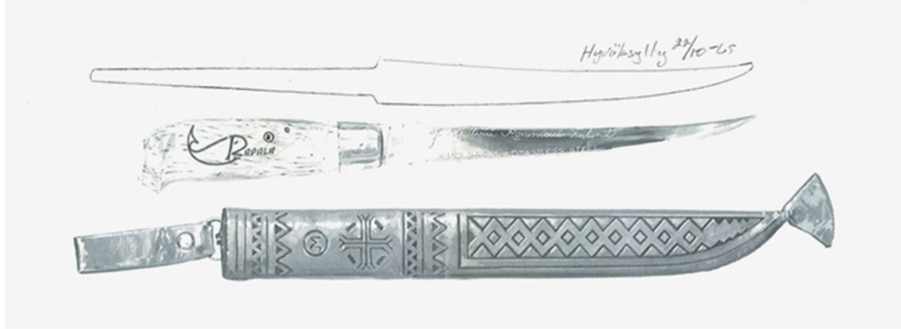
Story of the knives
The years pass, decades change. The company is passed on to new generations. The systems running the industry develop and production is expanded. The latter part of the 20th century has countless stories to tell, but we will let the knives do the talking. The company’s various phases gave birth to many well-known knives, which are still part of Marttiini’s selection. The Handy, that many know and love, came to be in the 70s. There was even a version where the blade also acted as corkscrew! The year 1980 saw the introduction of the first part of Marttiini’s beloved animal-themed series of knives with the introduction of the Eagle knife. Another evergreen, the rattling Witch's Tooth, came out towards the end of the decade.
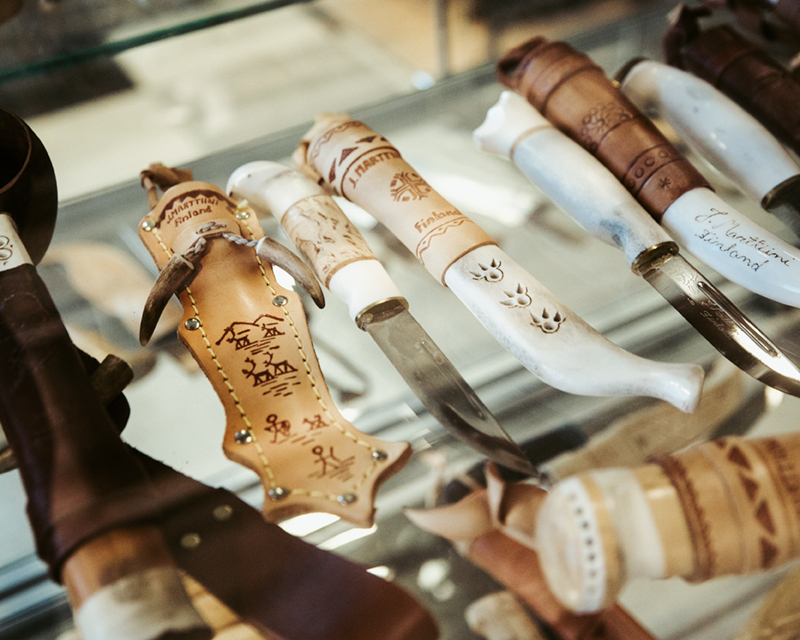
These, just like all Marttiini knives, tell their own story about the company’s long journey. Almost a century has passed since Marttiini was founded, but the past decades are still present. All you have to do is to pick up a knife. Do you still remember the Lynx, mentioned earlier in the story? The Lynx series continues to be one of Marttiini’s best-selling series of knives. Or perhaps Janne’s hometown of Kierinki? Later, a beautiful utility knife would be named Kierinki after the village. The recent favorite Aapa also has quite a tradition behind it: it combines the blade of a Lapp knife with the handle of a Lynx. The result is a sturdy knife that honors two great traditional knives.
Even though the journey has been long, the history was never lost. Not a week passes without us here at Marttiini hearing stories about knives that have witnessed a considerable part of the journey. Years, decades. You only have to look to see that history is still surprisingly close. Right at your fingertips.
